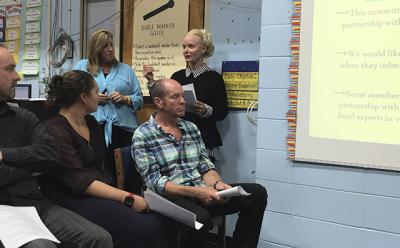No Springs School Bond

The Springs School facilities committee on Monday stopped short of recommending a bond referendum to finance a capital project, as it previously appeared poised to do, and instead introduced suggestions that will cost the school district money without proposing a way to pay for them.
The committee developed a prioritized list of steps in a phased-in approach to solving the school’s space needs, presented during the school board meeting. First on the list was installing at least four modular classrooms by the beginning of the 2016-17 school year, so the students in the Springs Youth Association building and the existing portable classroom buildings, which are approximately 40 years old, can learn in better facilities that are closer to the main school building.
Next on the list was renovating the playgrounds to make them compliant with the federal Americans with Disabilities Act. After that, the committee said, the school district should tackle the list of renovations, repairs, and A.D.A. issues needed to strengthen the school’s infrastructure. That list totals about $3 million, according to documents provided in May to the facilities committee from BBS Architects and Engineers, the consultant that helped the committee come to its recommendation. The facilities committee’s fourth priority was adding a middle school gymnasium that could also be used as an auditorium.
“We didn’t decide on the amount of classrooms to add, but it was definitely a majority of the committee that decided we do need that space,” said Jodie Hallman, a teacher and committee member. “What that looks like we sort of stepped away from. We felt that the bigger plan had to come after the community saw the effort in getting the little things done.”
No price tag was attached to the committee’s recommendations. The facilities committee’s work was strictly on an advisory basis to the school board, meaning nothing is set in stone until the board finalizes its own plans.
However, the school board on Monday approved the transfer of $1.75 million to its capital reserve fund from last year’s school budget surplus. That is the reserve fund that was supposed to fund the new parking lot and other campus improvements that the community voted down in May. That reserve fund now totals $3,751,000, according to Carl Fraser, the interim business administrator. Mr. Fraser said Tuesday that the reserve fund could theoretically be spent on modular classrooms and renovations in the future.
“Once the board has made a decision on how they would move ahead with the capital work, then this money that’s set up can be used with the approval of the voters for any capital work that is planned,” Mr. Fraser said. “It depends now on the total cost of whatever project is finally approved by the board. If a project for, say, $15 million is approved based on the work that’s planned out, certainly the $3.7 million in the capital fund will offset the need to borrow all of the monies that the capital work isprojected to cost.”
Some of the facilities committee members said they would like to keep meeting to continue the space needs discussion, as well as help the board communicate with the community at large.
“It would be important to include local experts who do not have a financial interest in the building and the design of those facilities,” Susan Harder, a committee member, said with reference to BBS Architects, which advised the committee while concurrently submitting a bid in response to a request for proposals that called for ideas from architects and engineers.
“We would highly recommend that the school board continue this committee and add qualified volunteers who live in the town, and preferably in Springs, to consult with and advise the board,” Ms. Harder said, specifying the committee could use the help in the fields of landscape, construction, architecture, planning, maintenance, environmental issues, and other areas “particular to our town.”
Ms. Harder also said the committee suggested making School Street a one-way or no-through street during school hours from Sand Lot toward Old Stone Highway, and suggested adding more parking spaces off of School Street in such a way that parking in front of people’s houses is prohibited.
In the bigger picture, Ms. Harder said, “It may be useful to consider a consolidated seventh and eighth-grade school for Amagansett, Springs, and Montauk to further avoid overcrowding and located in a less sensitive area.”
